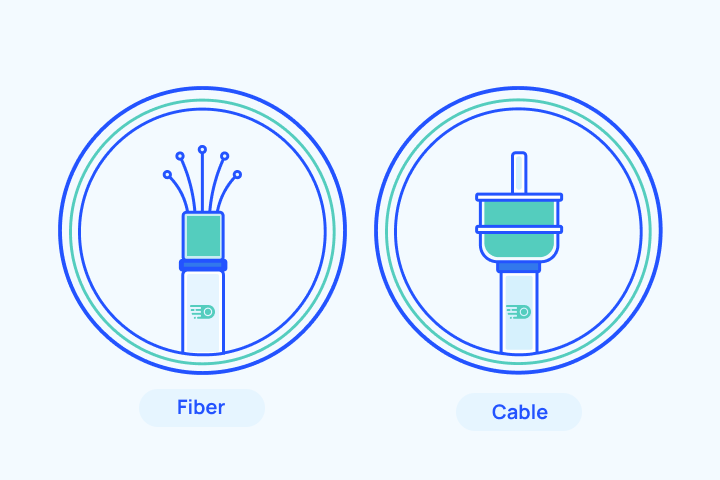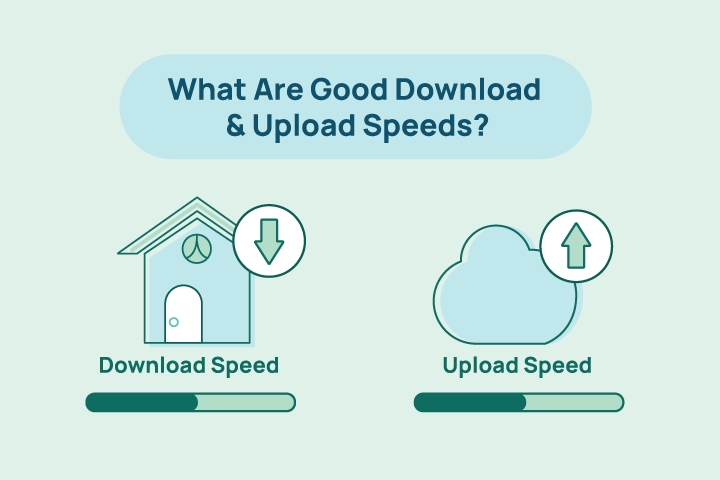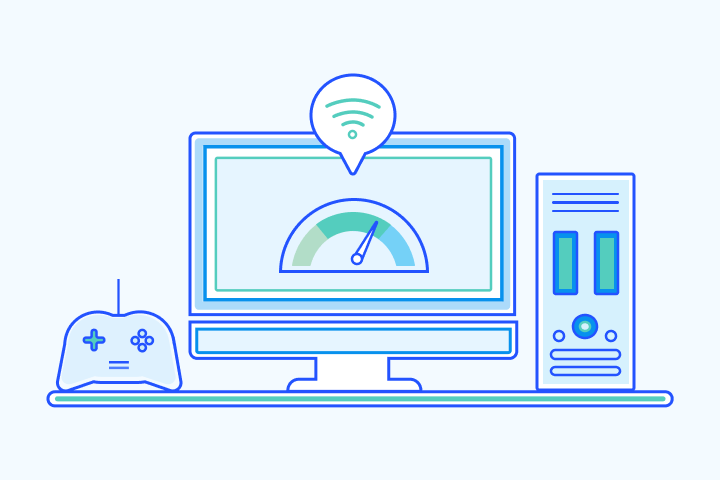Fiber vs Cable Internet: Key Differences

HighSpeedOptions prides itself on providing honest, quality content. While we may be compensated when you make a purchase through links on our site, all opinions are our own. Here's how we make money.
Table of Contents
Fiber internet and cable internet are the two fastest types of internet services available today. If your internet providers offer both options, here’s a look at the differences between them to help you make an informed decision.
What is Fiber Optic Internet?
Fiber internet is a high-speed connection that utilizes thin strands of glass bundled in a cable. Fiber transmits data as light through glass strands, making it one of the fastest internet types, with speeds up to 5 Gbps or higher in some areas. Fiber is the most recent major broadband technology, requiring new infrastructure to operate. It is therefore most common in high-density areas like urban and suburban environments.
Pros
Delivers symmetrical speeds, with multi-gig speeds potential as technology advances
It is less susceptible to environmental and electrical interference than copper-based networks
It’s nearly future-proof, since its full capacity has yet to be reached
Cons
Offers less availability than most other internet types due to limited infrastructure
Costs more per Mbps than many other internet services
May require high installation costs for homes not prepped for fiber
Top Fiber Internet Providers
- Best internet protection
- Unlimited data included
- No credit checks
What is Cable Internet?
Cable internet uses the same copper coaxial lines that deliver cable TV to millions of homes. Since it uses the existing cable infrastructure, it is widely available. Most homes built in the last 20–30 years are pre-wired with coaxial lines, making cable internet widely accessible. Cable internet offers speeds up to 1 Gbps, but some cable providers, like Xfinity, have plans that exceed that speed.
Pros
Uses existing infrastructure, making it widely available—even in some rural areas
Supports speeds above 1 Gbps
Provides a comparatively lower cost per Mbps than other connection types
Cons
Slows during peak hours because it is a shared connection
Imposes data caps on many provider plans
Requires 12- or 24-month contracts for most promotional prices
Top Cable Internet Providers
- Same-day installations
- 8+ million free WiFi hotspots
- Unlimited data available
- Contract buyouts up to $500
- Free access to WiFi hotspots
- Nationwide availability
- Low introductory prices
- Excellent customer support
- Blazing fast speeds
What Are the Main Differences Between Cable and Fiber Internet?
Fiber and cable are broadband internet services that can reach or exceed internet speeds of 1 Gbps. But that is where their similarities end.
Fiber internet:
- Transmits data more efficiently and resists interference from weather and electromagnetic sources
- Supports significant speed growth as technology continues to advance
- Remains less widely available due to limited network infrastructure
- Fiber upload speeds match download speeds (symmetrical)
Cable internet:
- Experiences more interference, especially from electromagnetic sources
- Reaches speeds above 1 Gbps but has less long-term speed potential than fiber
- Offers broad availability thanks to existing infrastructure and home readiness
- Cable upload speeds top out around 50 Mbps
Comparing Monthly Costs: Fiber vs. Cable Internet
| Category | Fiber Internet | Cable Internet |
| Starting Price (Promos) | $50–$60/month | $30–$45/month |
| Average Standard Price | $70–$100/month (post-promo) | $60–$85/month (post-promo) |
| Gigabit Plans | $70–$90/month | $65–$100/month |
| Installation Fees | $50–$200 (often waived during promos) | $0–$100 (commonly waived) |
| Equipment Rental | $10–$15/month for router (ONT provided by ISP) | $10–$20/month for modem/router gateway |
| Bring Your Own Equipment? | Router: Yes (ONT still required from ISP) | Yes (modem + router, if compatible) |
| Contracts | Often no contracts; month-to-month available | Frequently 12–24 month contracts for promo pricing |
| Category | Starting Price (Promos) |
| Fiber Internet | $50â$60/month |
| Cable Internet | $30â$45/month |
| Category | Average Standard Price |
| Fiber Internet | $70â$100/month (post-promo) |
| Cable Internet | $60â$85/month (post-promo) |
| Category | Gigabit Plans |
| Fiber Internet | $70â$90/month |
| Cable Internet | $65â$100/month |
| Category | Installation Fees |
| Fiber Internet | $50â$200 (often waived during promos) |
| Cable Internet | $0â$100 (commonly waived) |
| Category | Equipment Rental |
| Fiber Internet | $10â$15/month for router (ONT provided by ISP) |
| Cable Internet | $10â$20/month for modem/router gateway |
| Category | Bring Your Own Equipment? |
| Fiber Internet | Router: Yes (ONT still required from ISP) |
| Cable Internet | Yes (modem + router, if compatible) |
| Category | Contracts |
| Fiber Internet | Often no contracts; month-to-month available |
| Cable Internet | Frequently 12â24 month contracts for promo pricing |
What Equipment Do You Need for Fiber vs. Cable Internet?
Fiber internet requires a specific terminal in your house, whereas most homes are wired for cable. Here’s a closer look at the equipment and installation differences between fiber and cable internet:
Fiber Internet
- Installation costs: Usually $50–$200, though many providers waive the fee during promotions.
- What you need: A technician installs an Optical Network Terminal (ONT) in your home. The ONT converts the light signals from the fiber line into data your devices can use. You’ll also need a router to connect Wi-Fi devices.
- Bring your own? You can often use your own router for Wi-Fi, but the ONT is provided and managed by your ISP.
Cable Internet
- Installation costs: Typically $0–$100; many ISPs include basic setup with new service.
- What you need: A cable modem that connects to your coaxial line and a router for Wi-Fi. Many providers bundle these in a single modem/router “gateway.”
- Bring your own? Yes. Most cable providers allow you to purchase your own compatible modem/router, which can save $10–$20 per month in rental fees.
Takeaway: Fiber setup is more specialized because of the ONT, but once installed, it’s plug-and-play. Cable equipment is easier to swap and customize, giving you more flexibility to save on equipment costs.
Fiber internet is usually 3–5x faster for uploads than cable.
Which Is Better for You: Fiber or Cable?
When deciding between fiber and cable, the “better” option depends less on technical specs alone and more on your specific needs and circumstances.
Families with Kids Streaming on Multiple Devices
- Fiber: Handles heavy, simultaneous streaming in 4K/HD across multiple devices with minimal buffering, even during peak hours. Symmetrical upload speeds also support kids uploading content (e.g., TikTok, YouTube).
- Cable: Can work for families but may slow during peak evening hours, especially if many neighbors are also streaming. Better suited for smaller households or lighter streaming use.
Remote Workers and Students
- Fiber: Ideal for video conferencing (Zoom, Teams), cloud file sharing, and VPNs. Low latency and reliable uploads ensure smooth calls and consistent performance.
- Cable: Adequate for most remote work tasks, but users may experience video call drops or lag if multiple devices are active at the same time.
Gamers
- Fiber: Best choice for serious or competitive gamers. Very low latency, stable jitter, and minimal packet loss create a smoother gaming experience. Upload speeds also help with game streaming (Twitch, YouTube Gaming).
- Cable: Fine for casual gaming, but higher latency and occasional jitter can cause lag spikes in competitive online play.
Casual Browsers and Streamers
- Fiber: Overkill for users who mainly check email, browse, or stream on a couple of devices. Still beneficial for future-proofing if available.
- Cable: More than sufficient for casual use. Lower entry-level costs make it a budget-friendly option for households with lighter needs.
Businesses and Home Offices
- Fiber: Strongly recommended for businesses or serious home offices. Dedicated, symmetrical bandwidth ensures reliable uptime for multiple employees, large file transfers, VoIP, and secure connections. Many fiber plans include SLAs (Service Level Agreements) for guaranteed performance.
- Cable: Works for small offices with lighter usage but may lack the stability and guarantees needed for mission-critical operations. Performance may fluctuate during peak hours.
Bottom Line: Fiber delivers superior performance in speed, reliability, and long-term scalability, but cable remains the practical choice where availability and cost are key factors.
Fiber vs. Cable Internet at a Glance
| Category | Fiber Internet | Cable Internet |
| Speed Potential | Multi-gigabit (1–10 Gbps), symmetrical uploads & downloads | Typically up to 1 Gbps, faster downloads than uploads |
| Reliability | Consistent performance, unaffected by neighborhood usage | Can slow during peak hours due to shared bandwidth |
| Latency | Very low (<10 ms); excellent for gaming and video calls | Higher (10–30 ms), but still solid for most uses |
| Jitter | Minimal; stable for real-time apps | More variable; can affect gaming and video calls during congestion |
| Packet Loss | Rare under normal conditions | More prone during peak congestion or poor signal quality |
| Data Caps | Usually unlimited with most providers | Often capped around 1.2 TB/month; overage fees may apply |
| Availability | Expanding quickly, available to ~56% of U.S. households | Broader reach, ~80–90% of U.S. households |
| Cost | Starting ~$50–$70/mo; price per Mbps falling as competition grows | Starting ~$30–$60/mo; promotional pricing common, but can rise after intro period |
| Installation & Equipment | Installation fees can range $50–$200 (sometimes waived). Requires an Optical Network Terminal (ONT) plus router. Some ISPs provide equipment; customers may use their own router in many cases. | Installation typically $0–$100 (often included). Requires a cable modem and router (or gateway). Customers can usually supply their own modem/router if compatible with ISP. |
| Future-Proofing | Built for next-gen speeds and applications | DOCSIS upgrades extend potential, but may lag behind fiber long term |
| Category | Speed Potential |
| Fiber Internet | Multi-gigabit (1â10 Gbps), symmetrical uploads & downloads |
| Cable Internet | Typically up to 1 Gbps, faster downloads than uploads |
| Category | Reliability |
| Fiber Internet | Consistent performance, unaffected by neighborhood usage |
| Cable Internet | Can slow during peak hours due to shared bandwidth |
| Category | Latency |
| Fiber Internet | Very low (<10 ms); excellent for gaming and video calls |
| Cable Internet | Higher (10â30 ms), but still solid for most uses |
| Category | Jitter |
| Fiber Internet | Minimal; stable for real-time apps |
| Cable Internet | More variable; can affect gaming and video calls during congestion |
| Category | Packet Loss |
| Fiber Internet | Rare under normal conditions |
| Cable Internet | More prone during peak congestion or poor signal quality |
| Category | Data Caps |
| Fiber Internet | Usually unlimited with most providers |
| Cable Internet | Often capped around 1.2 TB/month; overage fees may apply |
| Category | Availability |
| Fiber Internet | Expanding quickly, available to ~56% of U.S. households |
| Cable Internet | Broader reach, ~80â90% of U.S. households |
| Category | Cost |
| Fiber Internet | Starting ~$50â$70/mo; price per Mbps falling as competition grows |
| Cable Internet | Starting ~$30â$60/mo; promotional pricing common, but can rise after intro period |
| Category | Installation & Equipment |
| Fiber Internet | Installation fees can range $50â$200 (sometimes waived). Requires an Optical Network Terminal (ONT) plus router. Some ISPs provide equipment; customers may use their own router in many cases. |
| Cable Internet | Installation typically $0â$100 (often included). Requires a cable modem and router (or gateway). Customers can usually supply their own modem/router if compatible with ISP. |
| Category | Future-Proofing |
| Fiber Internet | Built for next-gen speeds and applications |
| Cable Internet | DOCSIS upgrades extend potential, but may lag behind fiber long term |
Which Has Better Availability: Fiber or Cable Internet?
The Fiber Broadband Association reports that by the end of 2024, about 56% of US households had access to fiber internet. By comparison, the Internet & TV Association shows that nearly 90% of households have access to cable internet.
Put simply, more Americans can get cable internet.
One of the biggest reasons for this is the cost and complexity of deploying fiber infrastructure. Installing fiber means laying specialized cables, securing permits, installing network hardware, and ensuring there’s enough population density to make the investment worthwhile. In some cases, building out fiber costs over $8,000 per household.
For many providers, the investment isn’t financially viable.
That said, fiber internet does offer a big advantage for businesses. If your company needs a direct, private, and secure connection, with guaranteed speeds and no interference from neighboring networks, fiber may be the right fit. Especially for industries where uptime, data security, and real-time performance matter, fiber’s dedicated access is a clear win.
At the end of the day, even though fiber may outperform cable in speed, reliability, and latency, you might only have cable as your available option.
And as the saying goes, “Sometimes the best ability is availability.”
What Are The Key Takeaways Between Fiber and Cable Internet?
- Speed & Performance: Fiber is faster overall, with symmetrical uploads and downloads, very low latency, and minimal jitter or packet loss—ideal for gaming, video calls, and heavy cloud use. Cable offers fast downloads but slower uploads and can experience slowdowns during peak hours.
- Availability: Cable covers ~80–90% of U.S. households, making it the most widely available. Fiber is expanding quickly and now reaches ~56% of households, but coverage is still concentrated in urban and suburban areas.
- Costs & Contracts: Fiber plans often start around $50–$70/month and may include installation fees ($50–$200). Cable plans are usually cheaper up front ($30–$60/month) but often rely on promotional pricing, data caps, and long-term contracts.
- Installation & Equipment: Fiber requires a technician-installed Optical Network Terminal (ONT) plus a router. Cable uses a modem and router (or gateway), and customers often save by supplying their own equipment.
- Reliability: Fiber connections are less vulnerable to environmental interference and congestion, delivering consistent speeds. Cable can be more affected by neighborhood usage and network congestion.
- Best for Different Users:
- Families & Streamers: Fiber handles multiple 4K streams without buffering; cable is fine for lighter use.
- Remote Workers & Students: Fiber ensures stable video calls and file sharing; cable works but may lag under load.
- Gamers: Fiber is best for low latency and stability; cable is acceptable for casual gaming.
- Businesses & Home Offices: Fiber’s symmetrical speeds and reliability make it the clear choice; cable suits smaller offices with modest needs.
If both options are available, fiber is the smarter long-term investment for speed, stability, and scalability. If fiber isn’t available, cable remains a practical, widely accessible alternative.
Fiber vs. Cable: The Clear Choice for the Future
Both fiber and cable internet deliver fast, reliable connections, but their strengths differ. Cable wins on availability and affordability, making it a solid option where fiber hasn’t reached yet. Fiber internet is built for tomorrow—delivering symmetrical speeds, lower latency, and virtually unlimited scalability.
If you have access to fiber, it’s the smarter investment for speed, stability, and long-term value. If not, cable still offers strong performance that keeps most households connected without compromise.
Ready to upgrade? Enter your zip code below to compare providers and plans available near you.
Frequently Asked Questions: Fiber vs. Cable Internet
Yes, fiber internet is generally considered better than cable because it offers faster upload speeds, lower latency, and more reliable performance. However, cable remains a strong option where fiber isn’t available, especially since it covers more households nationwide.
Fiber is usually faster, particularly for uploads. Most fiber plans offer symmetrical speeds—meaning uploads and downloads are equally fast—while cable typically prioritizes download speeds. If you frequently video conference, back up files to the cloud, or game online, fiber’s speed advantage will be noticeable.
Yes. Fiber internet is generally more secure because data travels as light signals through glass strands, making it very difficult to tap without physically cutting the line (which would disrupt service). Cable internet, on the other hand, transmits data over shared copper lines, which can be more vulnerable to signal interception or congestion-related risks. For most households, both are safe, but fiber offers stronger built-in protection against tapping.
Cable internet is still more widely available, reaching about 80–90% of U.S. households. Fiber coverage is expanding quickly, now serving more than half of U.S. homes, but cable maintains broader reach in suburban and rural areas.
For businesses that rely on uptime, data security, and high-volume transfers, fiber is the stronger choice. Its dedicated bandwidth and symmetrical speeds make it ideal for industries that can’t risk downtime. Cable is often fine for small offices with lighter needs, but fiber provides more stability for mission-critical operations.
If you can get fiber, it’s typically the smarter long-term investment thanks to its speed, reliability, and future scalability. If cost is your top priority and your usage is more casual—browsing, streaming, or online gaming—cable may be the more practical choice.
Find providers in your area

Table of Contents











